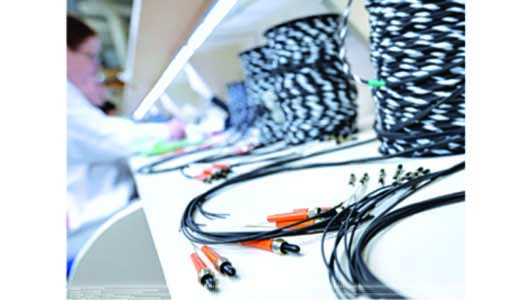OMC, the pioneer in optoelectronics design & manufacture, now offers a bespoke fibre optic datalink design & manufacturing service for industrial applications that require secure information transmission in environments that suffer from electrical interference or contain combustible dust which can cause explosions.
Explains William Heath, Director, OMC: “The increasing use of industrial IoT (IIoT) practices means that more and more information needs to be transmitted around factories between machinery and control centres. Wireless transmission can often be unsuitable in demanding electrically noisy environments – and traditional electrical solutions can also present difficulties when there are considerations such as interference, high voltages or flammable materials.”
Industrial fibre optic data communications links use LED sources, solid-state receivers and glass or plastic fibre to transmit data safely and reliably in industrial systems. The fibre SMA connector remains widely used in the industrial sector due to its excellent track record and ‘fit & forget’ nature. Polymer (plastic) fibre is often preferred for short transmission lengths due to its inherent robustness and low cost. OMC produces its own transmitter/receiver (Tx/Rx) components, as well as both polymer and glass fibre optic assemblies. Therefore, the company can design and deliver fully characterised fibre optic datalinks that meet the specific requirements of a wide range of applications.
Moreover, OMC’s proprietary ACA™ (Active Component Alignment) technology ensures that its fibre optic datalinks perform reliably, with 100% link consistency. During the datalink manufacturing process, each transmitter and receiver device is powered up, before the launch power or receiver sensitivity is measured, aligned and secured in place, with the device characteristics recorded and assured to be within the requisite performance envelope for the specific application. This enables much tighter performance tolerances to be achieved, leading to greatly enhanced long-term reliability – and in particularly demanding applications, this can be combined with OMC’s proprietary KSMA™ connector, with identifiable channel numbering, to ensure that the entire link performance measured during manufacture is, by design, repeated in the field.
Continues Heath: “Our components and systems have been designed to meet the demanding nature of IIoT installations. Key-coded connectors avoid incorrect mating, locking nuts enforce security and an all-metal housing construction reduces thermal issues. The robust housings feature flanges with secure mounting points to resist vibration and strain. Also, device receptacles have been designed to allow OMC’s fine particulate ingress shield to be optionally incorporated when the application environment is likely to contain very fine airborne particulates such as dust, flour, paint or oil spray. If these particulates find their way into the optical path between the transmitter/receiver and the cable, the link will be disrupted. With the ingress shield in place, once the connector is inserted, an automatic airtight barrier is formed between the optical interface and the outside world, eliminating particulate ingress.”












